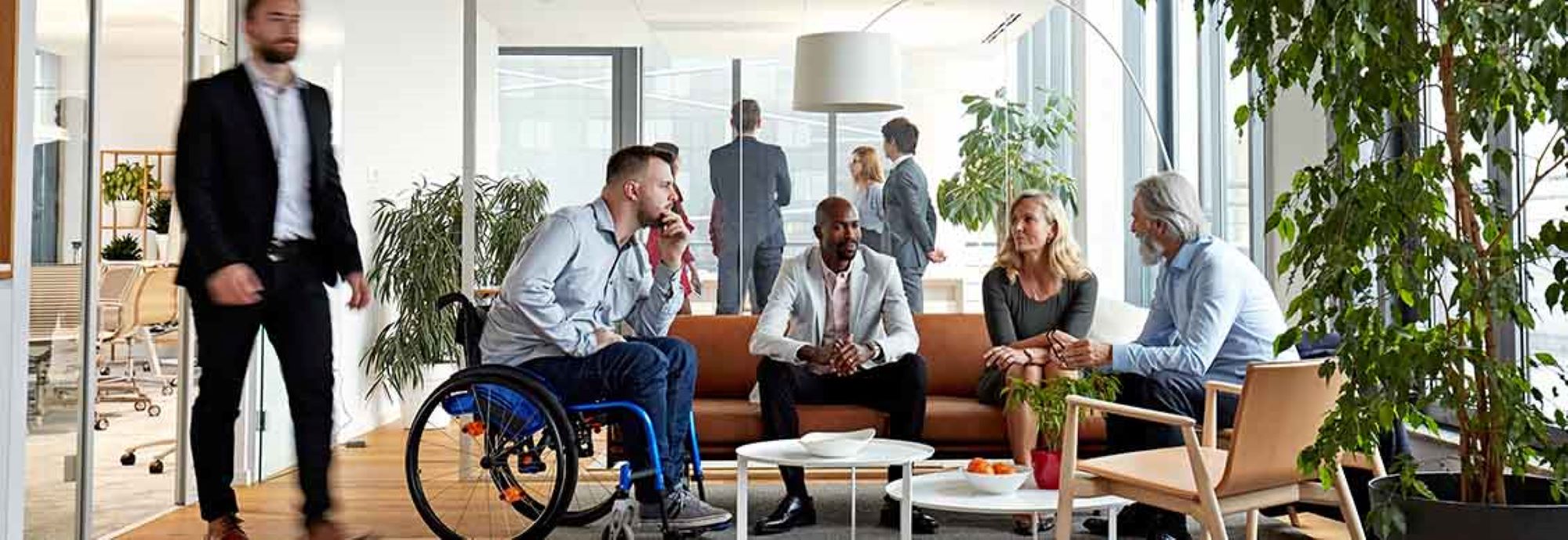Why disability access is a rising focus for companies
More people with disabilities are entering the workforce, largely thanks to the advent of remote and hybrid working.
A record 5.9 million disabled people aged 16-64 were employed in October in the U.S., up nearly 25% from February 2020, according to the U.S. Bureau of Labor Statistics, while disabled employment in the U.K. totaled 4.8 million at the start of 2022, an increase of 1.9 million since 2014, according to government data.
Yet despite having greater access to jobs, many physically disabled people still struggle to access their employers’ buildings.
“It’s the environment that disables people,” says Anne-Lyse Raoul, Head of Diversity, Equity & Inclusion (DEI) at JLL in EMEA. “There’s a need for more inclusion of people with disabilities in the conversation so we can learn how to adapt buildings to benefit everyone.”
Improvements are afoot. In a JLL recent survey, 46% of companies said they plan to accelerate investment to improve DEI in the workplace.
But while awareness of invisible differences such as neurodivergence is rising, “we have to still ask whether enough being done to make the workplace physically accessible to all,” Raoul says.
The scale of the issue
Around 1.3 billion people live with some form of disability, according to the World Economic Forum. In the U.S., 1 in 7 adults has mobility problem, according to the CDC – a number that’s likely to grow due to an ageing population
And while most people associate disability with wheelchairs, hearing and visual impairments – ranked second and third most prevalent by the World Health Organization – also pose challenges at work.
“The inclusion of disability in ESG criteria must be a priority for investors and companies,” says Ana Gorriti, lead consultant on JLL’s new DEI Standard for the Built Environment. “Glassdoor found three quarters of workers would prefer to work at a diverse company and employers are starting to understand that diversity must become more visible within their employee value proposition.”
Change is coming
At a city level, action is being taken to make public spaces more accessible. In Sweden, Skellefteå recently won the European Commission 2023 accessibility award, with infrastructure such as tactile paths, maps and information signs, text screens and audio announcements, as well as an SMS-service for blind and partially sighted people.
Companies are starting to follow suit. Take Unilever, which put inclusion at the heart of its communication strategies and revamped its Hindustan factory complex, focusing on design components such as handrails with Braille-inscribed location details and tactile indicators.
Shell is also evaluating its entire global real estate portfolio with ambitions to create an environment where people with disabilities excel.
New technologies are also emerging. Microsoft’s “Seeing AI” app narrates the world around the user. For those with hearing issues, the XRAi Glass app uses augmented reality glasses to transcribe and display speech to the wearer as real-time subtitles.
“Developing global strategies at this scale requires a long-term approach, and that means going beyond HR to engage teams from corporate real estate and portfolio management,” Gorriti says.
The fact that organizations now have roles dedicated to DEI is already a step in the right direction, says Raoul.
“You can’t cater for every eventuality but having someone to turn to for help with accessibility is progress,” she says.
A new mindset
With health and wellbeing the second highest employee priority, Raoul says it’s time to think beyond ramps and lifts.
“Disability can be acquired at any stage in life with age or health related conditions such as arthritis also causing people to struggle physically,” she says.
Rather than acting as a barrier, Gorriti says the physical environment should provide an accessible support system that benefits all. Much of this means greater consideration during the early phase of design and fit out – whether for new build or retrofit projects.
“Complying with health and safety regulations is the bare minimum. But by raising the bar to focus on functionality, supporting visual or hearing impairments and cognitive difficulties, autonomy can be provided regardless of specific needs,” she says.
DEI firmly on the agenda
While DEI may be lagging behind sustainability initiatives in the ESG space, Gorriti says it’s on the same path to becoming a non-negotiable social demand.
“It’s a learning journey and inclusiveness can’t be fixed overnight, but companies can begin by opening the conversation, listening and then drafting a roadmap for implementation. Even small investments can make a big difference,” she says.
Despite the many challenges, she believes organizations ignore accessibility at their peril.
“It’s no longer a question of whether it’s necessary, but how to achieve the best impact,” Gorriti says. “Firms who embrace inclusivity with people-centric cultures and accessible spaces will become future employers of choice and outperform others by attracting the best talent.”
https://www.us.jll.com/en/trends-and-insights/workplace/why-disability-access-is-a-rising-focus-for-companies



